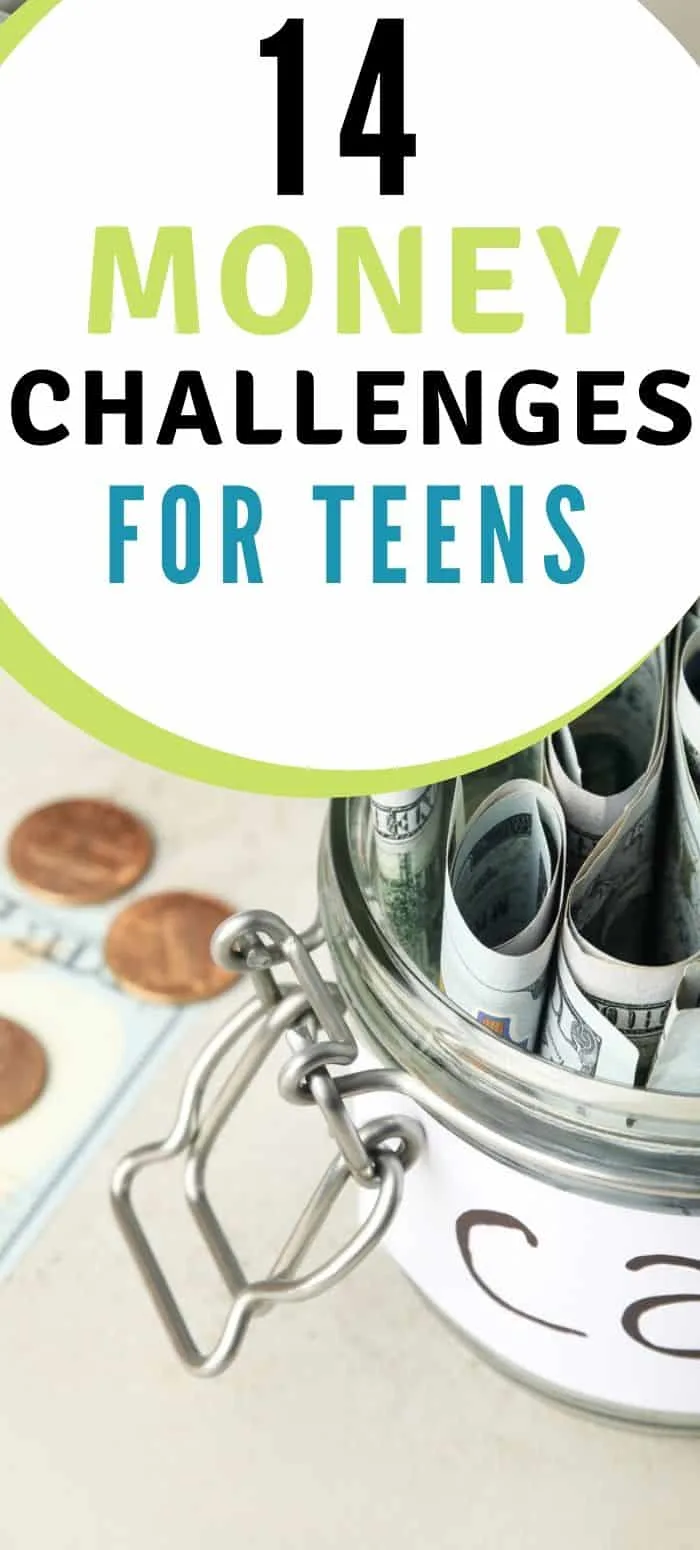14 FUN money and saving challenges for kids and teens to help them pick up money life skills naturally.
Naturally discovering money lessons YOURSELF is about the best money education you can get.

And with just a little prep work, we parents can help make this happen for our kid(dos) by presenting money challenges for kids and teenagers!
I’ve included 14 teen and kid money challenge ideas below that will naturally help them learn practical money skills plus build confidence in their abilities.
Don't forget, have some fun with this!
Money Challenges for Kids & Teens
First up is your money challenges for kids and teens to-do list.
Each of these challenges will teach your child something about money.
For more resources on teaching kids about money, check out:
- Money management skills for youth
- Teen money management
- Budgeting for kids
- How to budget as a teenager
- etc.
1. Use a Printable Money Savings Challenge for Kids
I would love to see your child challenged to create a short-term savings goal. In other words, one that will take them 30 days or less to achieve.
That's why I created the Unicorn Savings Challenge!
Go ahead, check it out.
2. Play Financial Hardship Monopoly
Everyone knows the game Monopoly, right (or at least has heard of it)?
I challenge your kid to play a round of Monopoly (one of the kid game challenges), but a bit differently this time: with one of the 6 financial hardships detailed below.
The fact is, many people have financial hardships in life – either as a default, or just periodically throughout their lives. And since we’re at the stage in your child’s life where hardships can actually be prevented, I think it’s a great exercise to make them feel a bit of how they would feel if they were actually stuck in these money situations.
Prevention is worth it, my friends.
So here you go:
- Low Credit Score
- Pile of Student Loans
- Starting Up a Business
- Being in Debt to Someone You Know
- Getting Laid Off
- Past Creditors Hunting You Down
How do you add these hardships into your game play? Check out my post for directions on adding in some money life skills for kids to your Monopoly play.
3. Profit-Making Challenge – Hot Beverage Competition
This is a different take on the lemonade stand — with a focus on teaching your child how to make a profit, something that's important whether or not they want to employ themselves one day — and gives families a reason to spend a little time together both indoors and outdoors during the winter. One of the fun challenges to do when bored!
Challenge kids to turn into a biz consultant for a day when they try to fulfill a need from the local Yeti Ski Lift. Jack, the owner, needs to create a new drink for a promo he’s doing. It’s gotta be a hot beverage. So, your kids are in competition to create the best-tasting drink that also makes at least a 60% profit.
Once the drinks are created, you all have a bonfire outside (heck, you can even light up the grill) and adults judge the various drinks to choose the winners.
4. Join a Stock Market Game
There are multiple LIVE stock market games online that your kiddo can join to dip their feet into investment waters.
Choose one to dive right in:
Also, check out these stock apps for kids (with built-in parental controls).
5. Dinner Budget Challenge
Let your kid(dos) take over the kitchen for the night. Give them a budget to work with, and help them to choose a meal to make based on that budget. Drive them to the store, and supervise as they pick out the ingredients (they might want to bring a calculator and add up the expenses as they go).
Then, help them as they prepare and serve the whole family the meal.
Here’s a link to 30 recipes that kids can cook to get you started.
6. Find and Apply to One Scholarship
This could be for college, for a summer camp, for a program they really want to be part of; for anything, really. The point is to get kids invested in their future selves + help walk them through the process of finding and then applying for scholarship/grant money that is out there for the taking.
I’ve written an article about Linsey Knerl’s own son did this, winning $1,000 to put into his 529 college savings plan. Other contests they’ve entered so far have been coloring contests, essays, or simply a reading program goal reward with prizes varying between $25 and $20,000.
3 Places to Start their Money Search:
7. Tween (or Teen) Budget Challenge
Ever thought about handing over your cash budget envelopes to your teen or tween to be in charge of for a week?
Laurie from Passionate Penny Pincher came up with this challenge, where she puts one of her kids in the decision-making spot for household purchases in one spending category. The child is in charge of menu planning, grocery shopping, and deciding what the family eats.
The prize is: any money her daughter doesn't spend above the cash budgeted amount is hers to keep. While I don't know how much that would equal, it does give quite a nice incentive for a child to put their all into menu planning! I love the kid money skills this challenge puts into practice.
Money Saving Challenge for Kids and Teens
Each of these challenges will teach your child something about saving money.
For more resources on teaching kids and teens how to save, check out:
- Teaching kids to save money
- How to spend less money as a teenager
- How much should I have saved by 18?
- How to save money as a teen (with or WITHOUT a job)
1. The Great Penny Challenge
Stuck at Home Mom’s The Great Penny Challenge is a savings challenge any change-loving kid can appreciate.
On Day 1, you put a penny in the jar. On Day #2, you put two pennies in the jar. On Day #365, you put 365 pennies in the jar.
At the end of the year, increasing by a penny a day will yield your child $667 (plus an appreciation for how even little bits of money can really add up).
2. 52-Week Savings Challenges for Kids/Teens
Mom Dot offers the 52-week savings challenge for both kids + teens:
- Kids Savings Challenge: Start putting $0.25 each week into savings, and raise that amount by $0.25/week. By the end of the year, you kid will have a nice $344.50 set aside.
- Teens Savings Challenge: Start by putting $1.00 each week into savings, and raise that amount by $1.00/week. By the end of the year, your teen will have $1,378 set aside!

3. Charity Contribution Challenge
Have your kiddo go through the process of finding a charitable cause they’re passionate about, and then setting aside money to donate to.
Your kid can follow these steps:
- Make a list of a handful of causes that you’re interested in, or passionate about. It could be a specific animal – whales, lions, penguins – or a cause, such as rain forest, feeding kids, helping the homeless, etc.
- Go to CharityNavigator.org, and search for charities that deal with these causes.
- Choose a charity, based on their score/mission on Charity Navigator.
- Start to set aside 10% of allowance money/earnings to donate to this charity. If this is too open-ended, then decide on a set amount of time that you'll set aside 10% of your money to donate such as for two months, one month, six months, or a year.
- Actually make the contributions!
Hint: Your child doesn't have a lot of money to donate right now. But one day they will! So show them that their little bit of money can go a long way by choosing from a list of charities where less than $12 goes a really long way.
4. Zero-Cost Entertainment Night Challenge
Each of your kid(dos) takes a turn of planning a family fun night. Choose the night of the week, and let them know any rules you have to begin with.
Now here’s the catch: they need to plan a night of fun that costs NOTHING (by “nothing”, I mean that you can set the rules, such as gas to get to somewhere like a park is okay, but no purchases made from a store).
Help them to think outside of the DVR-box (though those can be nice as well!).
Like…
5. Become the Family Gas Finder
Your child can make a meaningful contribution to the household – something kiddos love – by being in charge of researching which gas station has the cheapest price.
Help them sign onto GasBuddy.com and look the costs up. Let them do this once a week or once a month to see how gas prices have changed, and if another station is cheaper.
Bonus: Talk to them about how many miles away the gas station is, and if it’s acceptable to travel there for the amount you’ll be saving.
6. The BIG KAHUNA Savings Challenge
Your kids probably want to do something “outrageous.”And by outrageous, I mean or out-of-budget for your family. Maybe you feel a little guilty for saying no; maybe you have absolutely no intention of ever giving in on this.
Whatever that big thing is…offer this to your kid: If you can save half of the cost to do it/buy it, then I’ll kick in the other half and we’ll actually do it.
Seriously.
Maybe it’s:
- Buying a day pass to a theme park.
- Spending the night at the beach an hour from your home instead of doing a day trip.
- Buying a (used) car when they’re 16.
- Getting a dog.
- Going to see Taylor Swift in concert.
Not only will this thing not cost you as much, but you’ll have cemented some “cool parent” points in your child's memory. Not bad.
And when they lose determination because they don’t believe they’ll ever reach their savings goal? Then use it as a teachable money moment with these 3 goal-saving steps.
7. Money Growth Challenge
Are you trying to figure out how the heck others teach children to save (maybe because your own kiddo hasn't exactly picked up on the notion)?
Maybe there's a better way to go about it than just pleading with your child each time they receive an allowance or other source of money.
If you want to teach children to save, then you need to make it a fun discover-able activity with guaranteed results (if they stay the course).
The least risky method available to make money grow − thanks to the FDIC insuring bank accounts up to $250,000 each − is to put it into a savings account with an interest rate.
You and I both know this is not only because the bank is paying you for using your money, but also because of the magic of Compound Interest (or when interest earned on savings starts earning its own interest).
I could include one of those cool tables here (at least I find it cool, but I'm a nerdy numbers person) that shows this concept.
Or…
Your little one could experience it right before their very eyes, on their very own money that they get to keep.
Which do you think they'd get more from? (Hint: I think it's pretty telling that I still remember the very details of that plant experiment some 25 years later. And watching their own money grow? Well that's monumentally more interesting than watching plants grow).
Here's Your Child's Money Growth Experiment
You'll need a little seed money to start. To find this money you can:
- Have them use their own
- Gift them the funds
- Save any money they receive as gifts (say, around the holidays?) until they have a sizable enough sum to see some results
Looking for some seed money to get this experiment started? Sign up for a CapitalOne360 Savings Account for your child. You can get a 10% return on your money through my referral link ($25 is deposited into your account as long as you use this link to open a regular savings account + deposit $250 to start).
Once you've sourced the money (with the low interest rates of today, you'll need at least around $50, doubled, in order to see this in action; so $100 is recommended), take the following steps:
Step #1: Open up a Savings Account with the highest interest rate you can find. Deposit half of the money into this account.
Step #2: Stash the other half of the money in a clear jar at home. A washed-out jam jar works fine.
Step #3: Let both amounts of money sit for an amount of time. Six months would be best, though your little one might lose their attention span by then. I would say three months at least.
Step #4: Decide how often to let your child check their balances. You can also set a reminder date on your calendar six months out to check everything over. First, have your child count the money in the jar. Then have your child check their savings account balance.
WOAH. The Savings Account money should have grown! But of course the same amount that was put into the jar to begin with will still be there (unless there's any jam-jar, money fairies out there that I don't know about).
If you'd like a preview of what your child will see at the end, check out this compound interest calculator. Unfortunately, the shortest duration you can input is 1 year; however, the chart will allow you to estimate the outcome after six months (make sure to check “monthly” for compounding in Step #4, which is what most banks will do).
Teach children to save little bits of money today to prime them for a money-growth mindset that will make a big difference when they've got BIG bits of money to play with. Looking for some seed money to get this experiment started? Sign up here for a CapitalOne360 Savings Account for your child with at least $250. You can get a 10% return on your money through my referral link ($25 is deposited into your account as long as you use this link + deposit $250 to start).
8. Kid's Save Age Challenge
What if your child accepted the challenge to save money in the amount of their age, every month, until they turned 18? They'd have a whole lotta savings, that's what.
(Well, they might give up before then, but they could just try this for a few months).
Here's how Kristy from Money Bliss's challenge works:
- Each month, your child deposits the amount of their age in dollars into their savings account (so, if they're 7 years old, they deposit $7 each month into their account).
- Do this until they're 18, with no withdrawals
Kristy calculates that if a person does this from ages 3 to 18, they'll have $2,000 set aside (not to mention the compound interest earned).
And if you don't think your child will last that long (few will)? Then just chop this down to something more manageable, like a six-month challenge. That will show them that they truly can save money!
Well, that's it. Which money challenge are you most excited to introduce to your child?

Amanda L. Grossman
Latest posts by Amanda L. Grossman (see all)
- 50 Banking Activities for Kids (Student Financial Literacy) - February 14, 2024
- 14 Christmas Activities for High School Students (they’ll Actually Find Cool) - December 1, 2023
- 3 Fun Selfie Scavenger Hunts for Teens (Christmas, Fin Lit, etc.) - November 27, 2023

